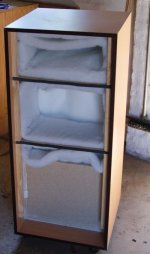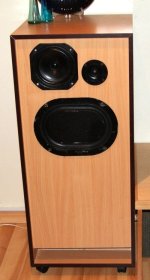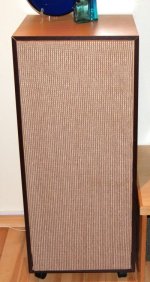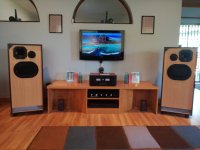What do you mean by that ?
https://www.mathworks.com/videos/managing-code-in-matlab-scripts-97216.html
That is wise. What do you think of the argument I presented? For the record, I agree fully on the fact that a row of speakers doesn't resemble the typical home environment. But a dedicated listening room with one pair might or might not either.Nope, I am past getting angry with anyone
In my younger years I quite frequently could be found at a DIY store with 3 listening rooms, speakers aligned in row. And brought home various designs to test. To me the qualities (and differences) that mattered emerged perfectly during the sessions in the listening rooms. Exactly because I was able to switch swiftly between speakers. And thus aiding my hearing to notice the differences. Even between the same designs which only differed on cabinet construction. These are just my 2ct of course.
It will be quite a job to define the transfer function from woofer movement to actual sound pressure on the mid cone. FEA or possibly BEM would be of more help.
All these audio shops are now long gone and I am referring to the late eighties. There were many hi-fi and camera shops back then where you could actually go and audition equipment. I also read hi-fi magazines those days. All the speakers that I purchased was from such shops. In the span of about six years, I was a very eager audiophile and purchased Rogers LS35a, Linn Sara, KEF Cadenza, KEF Concerto, Later Apogee Lascala, very early Bowers and Wilkinson 801, I was very much into English speakers for their more warm characteristics and mostly promotions in the UK Hi-Fi media.
I still have the LS3/5, Concertos and Apogee. The Apogees was moved into storage last few days ago because they are to large to place anywhere since we moved into our cottage on the beach which is barely 180 sq metres. All my redundant amps, turntables, tape/cassette and speakers was handed down to brothers and family with an interest in Hi-Fi. I never built speakers simply because I was never a woodworking guy. For my Brother's 50th I gave him my ancient Linn LP12, Ittok, Asak from the late seventies, he was absolutely thrilled with it.
Electronics was far simpler for me because I had free access to PCB manufacturing, metal machine shoppe and test facilities. Since I retired ten years ago I have not touched a soldering iron and what I still have was from between 10 to 40 years ago. Mark, I cannot really answer your questions but in those days you arranged for audition and went to listen for the system in a unique sound room set up like a lounge. BTW there were no sound dampening materials back then, only thick carpets, curtains and padded furniture. When you left you got a written quotation for the equipment you were interested in.
I hardly "listen" to equipment performances these days, and what I would say about it is probably limited to what I can still hear and appreciate . Currently I would select some stuff on Tidal that has some memories attached to it and stream in the background while messing on the PC or reading a book, or just sit in the sun and relax.
I still have the LS3/5, Concertos and Apogee. The Apogees was moved into storage last few days ago because they are to large to place anywhere since we moved into our cottage on the beach which is barely 180 sq metres. All my redundant amps, turntables, tape/cassette and speakers was handed down to brothers and family with an interest in Hi-Fi. I never built speakers simply because I was never a woodworking guy. For my Brother's 50th I gave him my ancient Linn LP12, Ittok, Asak from the late seventies, he was absolutely thrilled with it.
Electronics was far simpler for me because I had free access to PCB manufacturing, metal machine shoppe and test facilities. Since I retired ten years ago I have not touched a soldering iron and what I still have was from between 10 to 40 years ago. Mark, I cannot really answer your questions but in those days you arranged for audition and went to listen for the system in a unique sound room set up like a lounge. BTW there were no sound dampening materials back then, only thick carpets, curtains and padded furniture. When you left you got a written quotation for the equipment you were interested in.
I hardly "listen" to equipment performances these days, and what I would say about it is probably limited to what I can still hear and appreciate . Currently I would select some stuff on Tidal that has some memories attached to it and stream in the background while messing on the PC or reading a book, or just sit in the sun and relax.
Last edited:
Meant to say apogee scintilla. Age is my enemy. Would have loved trying the Klipsch but never had the opportunity. US speakers was not really available here.
Agree; mid must be sealed from the woofer pressure, and woofer box size must be adjusted to make up for the volume occupied by the mid's enclosure.While it might work in a ported if I'm not mistaken the result would be that the midrange would be mauled. The internal preassure created by the woofer will be applied on the midrange, it would act as a high fs passive radiator.
It will be quite a job to define the transfer function from woofer movement to actual sound pressure on the mid cone. FEA or possibly BEM would be of more help.
If all you want is a transfer function then measure it and use the data file.
As we were discussing, is the speaker performance quantifiable? Yes it is. if you want a simulation model then pick your engineering programing language.
For the speaker being discussed I see a model that requires quantifying a passive radiator plus the mid-range output of the smaller driver.
I suspect that I would measure it first and see how close my model plots overlay the measured transfer function.
The woofers are isobaric and totally isolated from mid, which are in its own transmission line enclosure. Makes for a very large speaker but sounds fantastic. Bigger is always better. These are all KEF drivers. No measurements, but then I listen to it not look at a piece of paper, which to me is irrelevant.
Attachments
- Home
- Loudspeakers
- Multi-Way
- same sealed box for midrange and woofer?



